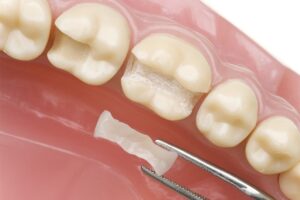Ceramic dental fillings
Ceramic tabs: Aesthetics and comfort
What is a ceramic tab?

Ceramic inlay – a modern, convenient, and aesthetic alternative to a traditional filling. Made from an individual impression, it perfectly fits the tooth, looks natural, and is practically invisible in the oral cavity. Despite the higher cost compared to a filling, a ceramic inlay is the preferred choice due to its comfort, reliability, and durability.
When should you choose a ceramic inlay?
Dentalgood Clinic recommends installing ceramic inlays instead of regular fillings in certain cases:
- In cases of significant tooth decay, when it is impossible to restore it with a regular filling the tooth remains “alive”.
- When the patient values the beautiful appearance of the teeth and the preservation of the anatomical shape of the dental arch.
- In cases of high tooth sensitivity, causing the patient to chew food only on one side, leading to uneven stress on the jaw.
Advantages of ceramic inlays over fillings:
Natural appearance: Ceramic inlays perfectly mimic healthy tooth enamel, without causing a sensation of a foreign object in the mouth.
Strength and durability: Due to the precise fit to the tooth and high-quality materials, inlays are a reliable and long-lasting solution.
Preservation of tooth functionality: Ceramic inlays help preserve chewing functions, preventing further enamel destruction and the risk of developing cavities.
Key differences between a filling and a ceramic inlay.
| Dental inlay | Dental filling | |
| Manufacturing Features | Based on individual parameters using the ZD model in the laboratory. | Made by the dentist in the patient’s oral cavity. |
| Production time | Up to 1 week | About 1 hour |
| Service life | Up to 10 years | No more than 5 years |
| Quality of fit | It does not cause a sensation of a foreign object in the mouth, conforms to all anatomical features of the patient’s oral cavity, and fits perfectly to the dental tissues. | The larger the filling, the more it interferes in the mouth. |
| The risk of recurrent decay | Low, if the teeth were treated before the inlay was placed. | High, as large fillings over time may shrink and, as a result, fall out. |
| Visibility | Invisible, matches the shade and shape of the patient’s teeth. | The filling and the tooth may differ in color. |
How is the process of making ceramic inlays carried out?
- Impression and individual design: The dentist takes an impression of the tooth, which is then transferred to the dental laboratory. There, an individual design of the future inlay is created, taking into account the color and shape of the tooth.
- Manufacturing in the laboratory: The inlay is manufactured using ultra-precise techniques, ensuring precise fitting to the tooth and a natural appearance.
- Installation in the clinic: After manufacturing, the inlay is installed in the clinic using special equipment, ensuring precise shaping of the tooth and secure attachment of the inlay.
Ceramic inlays are not only a way to restore teeth but also to preserve their natural beauty and functionality for many years.
CZK 10.000
The final cost of services is determined after a consultation with a dentist, taking into account the individual characteristics of the patient.